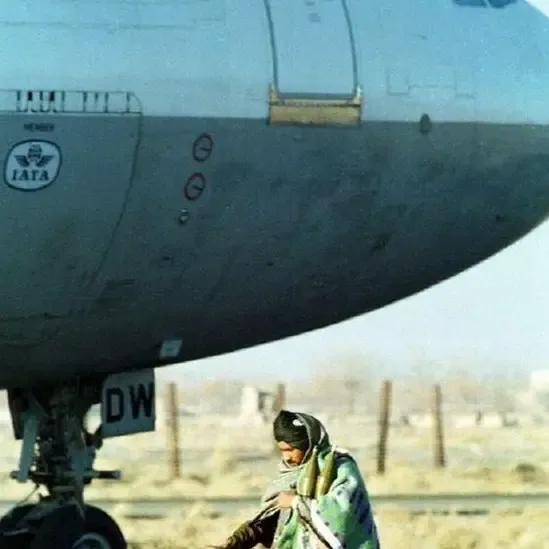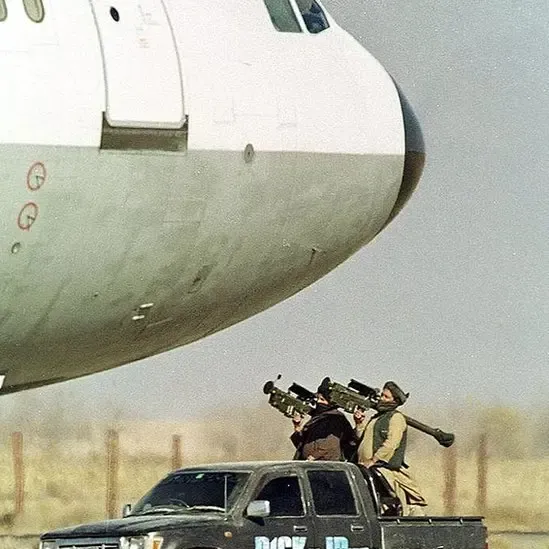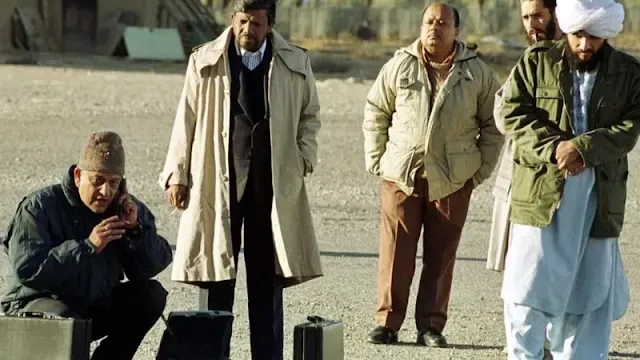IC814 How
did Indian Airlines Flight 814 arrive in Kandahar and what happened next?
The scenes
that are most often seen on TV screens after a plane is hijacked are of
security personnel and vehicles moving rapidly around the plane.
But two
decades ago, journalists were shocked when, instead of an armored vehicle, they
saw a man on a bicycle circling the hijacked plane at the airport in Kandahar
province, Afghanistan.
This story
is about an Indian plane that was hijacked after taking off and then landed at
three airports before being flown to Kandahar.
In history,
the importance of Kandahar province in Afghanistan was in no way less than
Kabul. But before the nineties, the international media did not give much
importance to this province.
However,
during the nineties, two major events that kept this region at the center of
world attention were the emergence of the Taliban and the capture of Kandahar,
and the hijacking of an Indian Airlines plane.
When and
where was the Indian plane hijacked?
It was on
December 24, 1999, when Indian Airlines flight 814 flew from Kathmandu, the
capital of Nepal, to New Delhi, the capital of India. In addition to 176
passengers, there were 15 crew members on board the Airbus, including the
pilots.
According to
media reports, the passengers were very happy to depart for their destination,
but their happiness did not last long because when the plane entered Indian
airspace, a masked man got up and walked towards the cockpit.
This masked
man threatened the pilot of the plane that if he did not turn the plane towards
Lahore in the west instead of Lucknow, he would blow up the plane with a bomb.
At the same
time, his four other masked companions also stood up and took up positions in
different parts of the plane.
Where did
the plane go before Kandahar Airport?
Although the
pilot of the plane, Captain Devi Sharan, diverted the plane to Lahore instead
of Delhi, he did not have enough fuel for this journey. This was because the
hijackers agreed to land the plane in the city of Amritsar in Indian Punjab.
According to
media reports, upon the plane's landing, the Indian police had prepared to take
action against the hijackers and perhaps the hijackers, sensing this threat,
forced the pilot of the plane to fly to Lahore without refueling.
Initially,
Pakistani authorities did not allow the plane to land in Lahore and the airport
lights were turned off for this purpose.
But due to
pressure from the hijackers, the pilot had no choice but to refuel at Lahore
Airport and was finally allowed to land the plane at Lahore Airport.
However,
after refueling, Pakistani authorities asked the pilot of the plane to leave
Lahore Airport immediately.
After
Lahore, the plane reached Dubai Airport, where the hijackers allowed 27
passengers to disembark.
According to
media reports, Indian authorities had requested permission from the United Arab
Emirates authorities to take action to free the plane from the hijackers at
Dubai Airport, but they refused.
The plane
then reached the airport in Kandahar, Afghanistan's second largest city, and
remained there until the hijacking ende
Kandahar
Airport the center of world attention
A few hours
after the plane landed in Kandahar, journalists began arriving there.
Since
Kandahar Airport is close to Quetta, the capital of Balochistan,
representatives from local and international media were the first to arrive in
Quetta.
The first
journalists from Quetta to arrive in Kandahar were Ayub Tareen of the BBC
Pashto service in Quetta, while those who arrived after them included senior
journalist Shahzad Zulfiqar and renowned photographer Banaras Khan of AFP.
Despite the
passage of two decades, all the scenes from the beginning to the end of the
hijacking are still in front of these people’s eyes.
Ayub Tareen
said that he stayed in a hotel in Kandahar on the first day. He said that the
incident took place in the month of Ramadan.
“When we got
up for Sehri, the people in the hotel started staring at us, wondering where
this beardless creature had come from. The people in the hotel were unaware
that an Indian plane had been hijacked and brought to their city's airport.
Cycling
and motorcycling?
Prince
Zulfiqar said that the strangest thing he saw at Kandahar Airport was a person
coming to the airport on a bicycle and circling the plane on the same bicycle.
According to
Banaras Khan, those performing security duties there used to patrol on bicycles
or motorcycles.
He said that
we were surprised that on such occasions there should be armored vehicles and
modern security equipment, but there was nothing like that.
According to
Prince Zulfiqar, upon his inquiry, he was told that the person who mostly used
to cycle around on a bicycle was an SHO-rank official in the police of the
airport area.
Severe
cold and lack of facilities?
Prince
Zulfiqar said that since he had gone to cover an important event, he did not
want to leave the airport at night because any major incident could happen at
night.
He said that
in those days it was bitterly cold and there was no proper accommodation.
He said that
they only had vehicles to protect themselves from the extreme cold. ‘The
journalists who had vehicles kept them running continuously to protect
themselves from the cold during the days they were there, and they kept trying
to protect themselves from the cold by sitting inside the vehicles.’
‘I did not
even untie the shoes I had worn from Quetta for two or three days due to the
extreme cold and the lack of proper sleeping arrangements there.’
He said that
where they could not sleep due to the lack of proper arrangements in the cold,
it was not possible for anyone to get enough sleep, given the importance of
this important event, so the journalists present there decided to sleep for
four hours in turn.
Despite
the danger, a big fire near the plane?
Since there
was no adequate arrangement to avoid the cold at the airport, especially near
the plane, the Taliban security personnel solved the problem by burning wood in
the field.
He said that
this wood was not burned very far away, but very close to the plane.
He said that
it is not appropriate to light a fire under any plane, but the Taliban did not
care about this at all and kept lighting a fire very close to it without taking
care of it.
Facing
problems with food and drink?
Prince
Zulfiqar said that just as the journalists were facing problems with
accommodation, they were also facing this problem with food and drink.
He said that
there were more problems in this regard for the first one or two days, but
later this problem was solved to some extent because food was brought there in
a Red Cross plane. However, some journalists also kept going to the city to
eat.
Ayub Tareen
said that the Taliban were providing food and drink to the passengers and other
people on the plane.
He said that
the Taliban’s food package consisted of a loaf of bread, a leg piece and a
mallet in a plastic bag.
He said that
the passengers on the plane objected to this food, saying that they could not
eat this food all the time.
He said that
after this, the food problem was solved because food from five-star hotels
started coming on a UN plane from Islamabad.
Preparation
for commando action
Banaras Khan
said that when the problem was not resolved in the first day or two, signs of
an action by the Taliban were seen.
He said that
‘there was no special force for this, but the same Taliban who were at the
airport wore the uniform that is usually worn by Air Force personnel over their
clothes, but in practice, no action was taken by the Taliban to avoid any
harm.’
However,
Prince Zulfiqar said that the people who were at the airport or those who came
and went from the Taliban had no experience in dealing with such a situation.
Prince
Zulfiqar said that during this time, the Taliban told him that the Indian
government had also carried out a commando action, but they did not allow it.
He said that
the Taliban had said that they could not allow any foreign force to operate on
their soil.
The shutdown
of the aircraft’s air conditioning
Banaras Khan
said that on the third day of the hijacking, the air conditioning system of the
plane stopped working.
He said that
the air conditioning system was essential to provide a better environment to
the hostage passengers, but when the air conditioning system stopped, the unrest
increased.
He said that
since Indian officials were continuously coming to Kandahar Airport, Indian
engineers also came with them.
He said that
one of these Indian engineers was taken inside and he fixed the fault and left.
He said that
after fixing the fault, when the Indian engineers were forced by journalists to
say something, they said that the hijackers did not let them go to any other
part of the plane but took them to the place where the fault was.
He said that
despite the great efforts of the journalists, the Indian engineers did not talk
much, but they said that ‘the hijackers are not ordinary hijackers but they
also have a lot of information about the plane.’
Was the
person who came to clean the plane the only source of information about the
plight of the passengers?
Prince
Zulfiqar said that the hijackers used to leave one person to clean the plane.
He said that
this one person was the source of information about the condition of the
passengers on the plane.
He said that
whenever that person came out, he would tell them that the passengers were in
great distress.
He said that
the person who cleaned the plane used to tell them that the hijackers did not
let them talk to any of the passengers, but asked them to finish their work
quickly and leave.
Did the
Indians understand that they were trapped?
Prince Zulfiqar
said that several Indian officials came out for negotiations and were talking
to the Taliban officials.
He said that
the Indian authorities would probably try very hard not to listen to the
hijackers, but from the evidence they saw there, they understood that this was
not possible.
“They
understood that they were trapped and there was no way out, which forced them
to bow down to the hijackers and release the militants for whose release the
plane was hijacked.”
Prince
Zulfiqar said that until the hijacking, Kandahar Airport was a hub for the
movement of high-ranking Taliban officials and Indian officials.
He said that
former Foreign Minister Abdul Wakil Mutawakil and former Aviation Minister and
Governor of Kandahar Mullah Akhtar Usmani, as well as former Indian Foreign
Minister Jaswant Singh, were prominent among the prominent officials of the
Taliban government who used to visit there.
He said that
Jaswant Singh had to visit Kandahar Airport twice.
Once he came
for negotiations, while the second time he came on the day when Maulana Masood
Azhar, Mushtaq Zargar and Ahmed Omar Saeed Sheikh, who were imprisoned in
Indian jails, were released and brought to Kandahar Airport on the demand of
the hijackers.
He said that
on the day the plane dropped, two planes arrived from India, one of which was
carrying Jaswant Singh.
He said that
the other plane probably brought the three militants, including Maulana Masood
Azhar.
Arrival of
the ambulance before the drop scene and recovery of the hijackers from the
plane
Prince
Zulfiqar said that before the drop scene of the hijacking, an ambulance arrived
and parked near the plane.
He said that
five masked hijackers came down from the front side of the plane hanging from a
rope.
He said that
they got down with lightning speed like commandos and got into the ambulance.
He said that
he saw the three militants who were released, including Maulana Masood Azhar,
and they probably also got into the same ambulance that contained the hijackers.
He said it
was not known where the men left the airport, but the hijackers and the
released militants had been ordered by Taliban authorities to leave Afghanistan
within two hours.
Passengers’
happiness?
Prince
Zulfiqar said that the hijacked plane was very close to where the journalists
were standing.
He said that
although the passengers were not allowed to go near the journalists, the
journalists could see their faces clearly.
He said that
as they got off the hijacked plane and climbed the stairs to enter the other
plane, they were so happy that they felt as if they had been given a new life.









Post a Comment